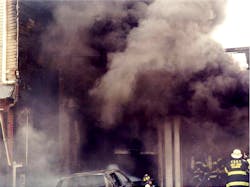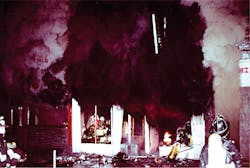Firefighter Safety: Cultural Change in a Traditional World
When we talk about incident command, we often reference “that’s how we always do things” or “that’s how it’s always been done.” We call that tradition—the thoughts, beliefs and actions that are carried from the past.
I believe that we must focus on the fire service culture, or the acceptance of those thoughts, beliefs and actions, and on the crew integrity—the actions that are demonstrated based on tradition that we accept as culture—in which these tasks are accomplished.
As incident commanders (ICs) or company officers, we create strategies based on things that we learned in the training environment, that we experienced on the fireground and that we heard about. We call that recognition prime decision-making, or RPDM. In some cases, this works and a successful outcome results. At other times, not so much. We could end up with serious injury or a line-of-duty death.
What all of us must strive to do is become a “master of our craft.”
Intellect vs. emotion
I believe that it’s safe to say that we all understand—or at least we should understand—that safety on and off of the fireground is everybody’s responsibility. At the same time, it’s widely known that, although the number of fires has decreased, the number of firefighters that are exposed to flashover or an unusual fire event has increased. We must understand the art and study the science of what we do.
It’s so easy to get caught up in the “just get in there and do it mode,” but it’s our obligation to understand the science and the behavior of fire and why it does or doesn’t do certain things in different types of occupancies. The understanding of fire dynamics and how that relates to flow path is a critical component to the success of your tactics. Reading the smoke and reading the building are critical to how you might want to approach the initial fire attack. You must stay in that intellectual mindset.
Fire behavior events, such as rapid fire spread, flashover, ventilation-induced flashover, backdraft, smoke explosion and wind-impacted incidents, are the categories that I focus on when I stand in front of the fire building.
Reading smoke probably is one of the first things that I’ll do, because that usually begins as I put together my windshield size-up.
Using Chief David Dodson’s theory, the four attributes for reading smoke are volume, velocity, density and color.
From a quick street read, I look at: smoke location; the pressure by which the smoke is leaving the building; and, as a quick reference, the smoke’s color, to just see whether it’s resulting from contents that are on fire or from the structure itself potentially burning. (As we know, fires burn faster and hotter and produce more smoke than they ever did because of modern-day building construction materials and furnishings.)
The understanding of fire dynamics and all of the study that’s been conducted by the National Institute of Standards and Technology and UL are invaluable tools for ICs and company officers who are in the field.
Typically, when the stages of fire are discussed, we key on ignition, growth, fully developed and decay. When I talk about the stages of fire, I add the fifth stage: flashover. At its simplest, flashover is the transition between the growth and fully developed stages. If you’re studying for the lieutenant’s exam, flashover is a transition in the development of a compartment fire when surfaces that are exposed to thermal radiation from fire gases that are in excess of 1,100 degrees F reach ignition temperature more or less simultaneously.
With most home furnishings now made of hydrocarbon- and synthetic-based materials, the production of smoke is almost 500 times more than the fires of yesterday. Although ventilation tactics still are quite necessary, they must be more coordinated with the movement of the hoseline and with the application of water. This is where the understanding of fire dynamics and flow path are so important.
Fire dynamics
Fire that’s in a confined space creates pressure, smoke and fire flows from an area of high pressure to an area of low pressure. We enter the fire area from a low-heat/low-pressure area. The heat and smoke move toward the opening that we create. This creates a flow path, or the movement of heat and smoke from the higher pressure within the fire area toward the low-pressure areas via openings. High pressure seeks low; hot seeks cold.
As heated fire gases move toward the low-pressure areas, the energy of the fire pulls in additional oxygen from the low-pressure areas. This creates a bidirectional air flow. Heat always is transferred from a high-heat area to a low-heat area. The hotter the smoke, the faster that it will travel.
For so long, we talked about the concerns of “pushing” fire from one room to another with a hoseline. In reality, we probably just didn’t understand the science of flow path.
Smoke as fire load
Smoke is unburned fuel. The most abundant gas in smoke is carbon monoxide. It has an explosive range of 12.8 percent–74.0 percent, with an ignition temperature of approximately 1,174 degrees F. All that said, we anticipate a fundamental fire load, such as furnishings of a home in a private dwelling or the commercial contents of a retail store, in the occupancies that we respond to. What we must consider more is the fuel load that we don’t anticipate, and that’s the production of smoke from those contents burning.
As the fire continues to burn and smoke stratifies at the ceiling level, not only is heat and pressure building in the “box,” but the space is shrinking as well. The “ceiling” becomes lower, and radiation and re-radiation become more prevalent. This is where the potential for flashover, rapid fire spread or some unusual fire event can take place. If we vent at the wrong time or in the wrong place, we create bidirectional flow of air and bring oxygen to the seat of the fire and create a ventilation-induced flashover. Failure to recognize these conditions can be catastrophic.
Risk-management at all levels
All of what’s described above—and so much more—happens as we stand in front of the building trying to command the incident and/or lead the first-due crew into operation. As a company officer, a risk-benefit analysis from the interior of the structure must take place, even though it might be contrary to the orders that come from outside. What you see or feel in your gut might be totally different than what appears to the IC from outside of the structure.
Ultimately, as a company officer, it’s your decision for how to keep your crew safe so “everyone goes home.” As the IC, it’s your obligation to remember that risk has a first and last name and that every strategy and tactic has a risk or cost associated with it. For every name, there is a family, a company and a community that ties back.
Some of you might be rolling your eyes. Nevertheless, I believe that risk management must be more eagerly discussed at the firefighter level, not just at the administrative level. We must train all of our people on the risk and frequency matrix. It certainly will help in the realm of knowing whether we have adequate resources and to read our own people—for when we pull up to work that we are commonly involved in or when we pull up to something that happens very infrequently. This aids the company officer regarding how closely to supervise the crew and what resources might need to be called by the company officer to assist.
Utilizing the risk and frequency matrix and sprinkling in some RPDM help you with “forecasting” events, such as what is probable to happen next. You can use this forecasting method for things that have a positive outcome as well as things that might result in a negative outcome. In many cases, what is predictable is preventable. That’s part of a very fundamental risk-management model that you can utilize on and off of the fireground.
Change the culture
When I talk about being a master of our craft, what I really mean is a jack-of-all-trades. As you continue to lead your people, you must be current and relevant, situationally aware, experienced, courageous, safety-minded and open-minded.
As technology changes and building construction methods change, the production of human-made materials also will change, probably not for the better from a fire service point of view. Cost-effective doesn’t usually equate to firefighter safety.
Please continue to train on the fundamentals of your job and to study the science and art of what you do every day. Remain situationally aware and ever vigilant. If you work toward these goals, you will change the culture in the way that you do business.
Let us all create some new thoughts, beliefs and actions together.
On that note, I leave you with this question: Do you have the courage to change the culture of the way that you do business so “everyone goes home”?
About the Author
Paul Wilders
Paul Wilders is a 37-year veteran of the fire service and currently the assistant chief instructor of the Nassau County, NY, Fire Service Academy. He is the former chief of the North Merrick, NY, Fire Department and a senior member of that department's training committee. Wilders is an instructor of national curriculum for the International Organization for Standardization and an advocate for the National Fallen Firefighters Foundation's Courage to Be Safe program.

